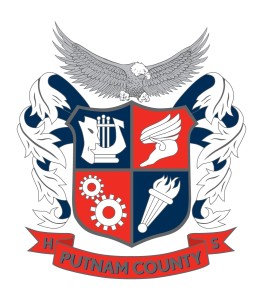Putnam County High School welding students showing off a see saw they made for the PCHS campus include, from left, Clinton Lea, Aaron Clark, Clinton
Clemons, Brandon Marshall, Tyler Deloach, Douglas Gordon, David Sides and Brandon Price.
The Eatonton Messenger
July 14, 2024
There are more than 25 students at Putnam County High School enrolled in welding courses through Central Georgia Technical College, all of whom are also Youth Empowerment for Success (YES) program members. Welding instructor, Aaron Clark, has always been a proponent of incorporating project-based learning into the welding curriculum as opposed to merely practicing on mundane six-inch steel plates or utilizing unrealistic 3D simulators.
In Clark’s class, students at all levels get to participate in the creation of welding projects throughout their time in the program, many of which are considered community service based projects. For example, last year, the school’s YES welding students fabricated 10 bike racks for distribution throughout the community. This year, those bike racks were donated to the Eatonton-Putnam Chamber of Commerce and installed for use along an Eatonton bike tour route.
This fall, YES students created three scarecrows as a part of their entry into Eatonton Main Street’s Art Bliz Scarecrow Contest to represent the different areas of the program. The welders combined their skills to create a scarecrow to represent their stake in the YES program, and the entire entry ended up winning first place!
However, the most recent buzz around the PCHS campus surrounded the large-scale playground equipment the welders built and installed. When you first arrive at PCHS you will now be greeted by a 24- foot, steel see-saw that has adjustable seats. Welding students also constructed a 24-foot monkey bar system with varying levels to increase the challenge of making the trek across them. Clark envisioned that these two projects could also benefit both math and science departments through fun, hands-on activities of their own too.
 Furthermore, earlier this semester, senior welding students competed at the Skills USA Leadership and Skills Conference (SLSC) at both regional and state levels. PCHS welders brought home four second place wins and one first place win at region, and also scored a third place win at state!
Furthermore, earlier this semester, senior welding students competed at the Skills USA Leadership and Skills Conference (SLSC) at both regional and state levels. PCHS welders brought home four second place wins and one first place win at region, and also scored a third place win at state!
Each of these examples provides evidence that Clark’s philosophy on teaching welding to PCHS students has had a very practical application, and supports a high level of achievement. In fact, this dual-enrollment program at PCHS is so successful that at this year’s graduation ceremony the senior welding students will be awarded a combined total of more than 30 Technical College Certificates (TCCs). What is even more impressive is that two of those ambitious senior welders, Austin Sanders and Sterling Underwood, also earned a degree from CGTC in Welding and Joining Technology in conjunction with their PCHS diploma.
The Youth Empowerment for Success Program at Putnam County High school was created with the main goal of providing students with opportunities and skills that will help them be successful when they leave PCHS! Former Principal Barry Lollis noted, “Our students’ successes and passions in their area of study are ignited by the quality of their instructors and the engaging strategies they utilize in their classrooms.”



